
Fragaria is a genus of flowering plants in the rose family, Rosaceae, commonly known as strawberries for their edible fruits. There are more than 20 described species and many hybrids and cultivars. The most common strawberries grown commercially are cultivars of the garden strawberry, a hybrid known as Fragaria × ananassa. Strawberries have a taste that varies by cultivar, and ranges from quite sweet to rather tart. Strawberries are an important commercial fruit crop, widely grown in all temperate regions of the world.
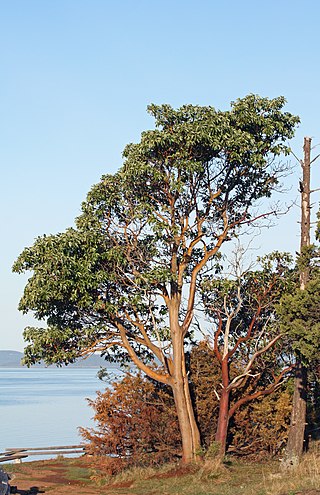
Arbutus menziesii or Pacific madrone, is a species of broadleaf evergreen tree in the family Ericaceae. It has waxy foliage, a contorted growth habit, and flaky bark.

Abies grandis is a fir native to northwestern North America, occurring at altitudes of sea level to 1,700 metres (5,600 ft). It is a major constituent of the Grand Fir/Douglas Fir Ecoregion of the Cascade Range.
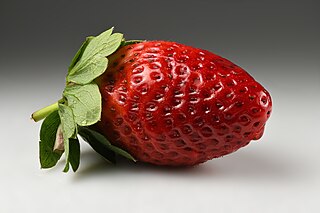
The garden strawberry is a widely grown hybrid species of the genus Fragaria, collectively known as the strawberries, which are cultivated worldwide for their fruit. The fruit is widely appreciated for its characteristic aroma, bright red color, juicy texture, and sweetness. It is consumed in large quantities, either fresh or in such prepared foods as jam, juice, pies, ice cream, milkshakes, and chocolates. Artificial strawberry flavorings and aromas are also widely used in products such as candy, soap, lip gloss, perfume, and many others.

Fragaria virginiana, known as Virginia strawberry, wild strawberry, common strawberry, or mountain strawberry, is a North American strawberry that grows across much of the United States and southern Canada. It is one of the two species of wild strawberry that were hybridized to create the modern domesticated garden strawberry.

Fragaria vesca, commonly called the wild strawberry, woodland strawberry, Alpine strawberry, Carpathian strawberry or European strawberry, is a perennial herbaceous plant in the rose family that grows naturally throughout much of the Northern Hemisphere, and that produces edible fruits.

Fragaria × vescana is a hybrid strawberry cultivar that was created in an effort to combine the best traits of the garden strawberry, which has large berries and vigorous plants, with the woodland strawberry, which has an exquisite flavour, but small berries.

Fragaria chiloensis, the beach strawberry, Chilean strawberry, or coastal strawberry, is one of two species of wild strawberry that were hybridized to create the modern garden strawberry. It is native to the Pacific Ocean coasts of North and South America.
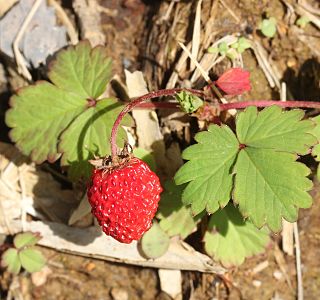
Fragaria iinumae is a species of strawberry native to Japan and eastern Russia.

Potentilla indica, known commonly as mock strawberry, Indian-strawberry, or false strawberry, often referred to as a backyard strawberry, mainly in North America, is a flowering plant in the family Rosaceae. It has foliage and an aggregate accessory fruit similar to that of a true strawberry. It has yellow flowers, unlike the white or slightly pink flowers of true strawberries. It is native to eastern and southern Asia, but has been introduced to many other areas as a medicinal and an ornamental plant, subsequently naturalizing in many regions worldwide.
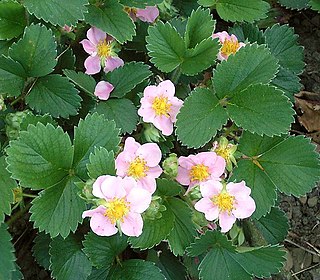
There are several commercially important hybrids between Fragaria and Comarum species in existence. A name for Fragaria × Comarum is available as × Comagaria Büscher & G.H. Loos in Veroff. [Bohumer Bot. Ver. 2(1): 6. 2010], along with the combination × Comagaria rosea (Mabb.) Büscher & G.H. Loos.

The Deschutes National Forest is a United States national forest (NF) located in Central Oregon, in parts of Deschutes, Klamath, Lake, and Jefferson counties. It was established in 1908, with border changes following in 1911 and 1915. The forest now encompasses almost 1.6 million acres (6,500 km2) along the east side of the Cascade Range. The forest is bordered to the south by the Fremont–Winema NF, to the southwest by the Umpqua NF, and to the west by the Willamette NF.

The Ecology of the North Cascades is heavily influenced by the high elevation and rain shadow effects of the mountain range. The North Cascades is a section of the Cascade Range from the South Fork of the Snoqualmie River in Washington, United States, to the confluence of the Thompson and Fraser Rivers in British Columbia, Canada, where the range is officially called the Cascade Mountains but is usually referred to as the Canadian Cascades. The North Cascades Ecoregion is a Level III ecoregion in the Commission for Environmental Cooperation's classification system.

Pineberry is a white strawberry cultivar with red seeds and a pineapple-like flavor.
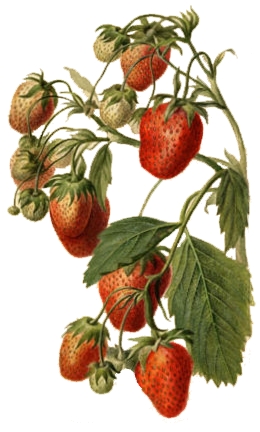
The breeding of strawberries started with the selection and cultivation of European strawberry species in western Europe in the 15th century while a similar discovery and cultivation occurred in Chile. The most commonly consumed strawberry species in modern times is the garden strawberry, a species derived from hybridization of two other species, with the scientific name Fragaria × ananassa, but there are many species of strawberries, several others of which are cultivated to some extent. The strawberry species fall into several different genetic types, based on their number of chromosomes. Strawberry growers have employed many breeding techniques, starting with traditional plant breeding and then moving on to molecular breeding and genetic engineering in the 20th century.
Erythronium elegans is a rare species of flowering plant in the lily family known by the common names Coast Range fawnlily and elegant fawnlily. It is endemic to Oregon in the United States, where it is known from about 12 occurrences in the northern Coast Range.

Fragaria orientalis is a diploid species of wild strawberry native to E. Asia – Eastern Siberia. It is occasionally cultivated as a novelty edible.
Fragaria pentaphylla is a tetraploid species of wild strawberry native to China. In Chinese, it is called the "five-leaf strawberry".
Erigeron cascadensis is a North American species of flowering plants in the family Asteraceae known by the common name Cascade fleabane. It has been found only in the state of Oregon in the northwestern United States, primarily in subalpine meadows in the Cascades mountain range.

The following outline is provided as an overview of and topical guide to strawberries:

















